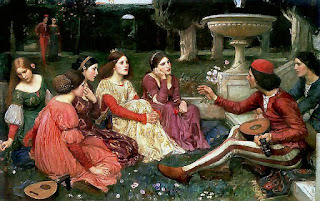The earliest mosaics, found in a temple in Mesopotamia, were roughly cube-shaped bits of stone, along with pieces of shell and ivory. Around 1500 BCE we start to see evidence of glazed tiles being used. Rome and Greece elevated mosaic use to a high art (although most named mosaic artists in the Roman Empire have Greek names).
The Middle Ages chose brightly colored glass and gold leaf to make mosaics. When Ravenna became the capital of the Western Roman Empire, it became the site of several magnificent buildings with equally impressive mosaics. When the Lombards were problematic, Pope Adrian I turned to Charlemagne for aid. For Charlemagne's reward, he was allowed to take away from Ravenna anything he wanted. What he wanted was Roman art and architecture, so a number of Roman columns, statues, and mosaics traveled north to become a part of his complex at Aachen.
Taking and re-using older architecture and artwork was actually a recognized practice, and the elements were called spolia, from the Latin for "spoils." An example of spolia in Aachen is the porphyry columns in the Palatine Chapel which likely came from Ravenna. Charlemagne must have liked what he saw in Ravenna, because his Palatine Chapel's design is very similar to the church of San Vitale in Ravenna. The Palatine's ceiling and walls are covered in mosaic that is clearly Byzantine in style (see the illustration).
As the 13th century approached, mosaicists were also painters. One of the best known now (in the Modern Age) was Giotto, whom we'll talk about next time.

.png)
























